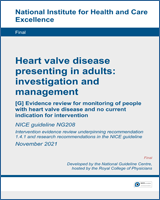
NCBI Bookshelf. A service of the National Library of Medicine, National Institutes of Health.
| Population |
Inclusion: Adults aged 18 years and over with diagnosed heart valve disease and no current indication for intervention, stratified by the severity of valve disease as follows:
Exclusion: Children aged less than 18 years. Adults with congenital heart disease (excluding bicuspid aortic valves). Tricuspid stenosis and pulmonary valve disease. People who have had prior heart valve repair or replacement (transcatheter or surgical). |
|---|---|
| Interventions |
Any of the following assessment strategies used for monitoring purposes, followed by appropriate valve intervention, in the specified population: Biomarkers (alone or in combination with echo):
Frequency will be categorised into the following groups:
|
| Comparisons |
Other active comparator listed above No monitoring (for example, tests only performed if new symptoms emerge/symptoms worsen) |
| Outcomes | Primary outcomes:
|
| Study design |
Randomised controlled trials (RCTs) and systematic reviews of RCTs. Published NMAs and IPDs will be considered for inclusion. If insufficient evidence is found from RCTs, non-randomised studies will be considered for inclusion. Important confounders NRS must be adjusted for:
|

NCBI Bookshelf. A service of the National Library of Medicine, National Institutes of Health.